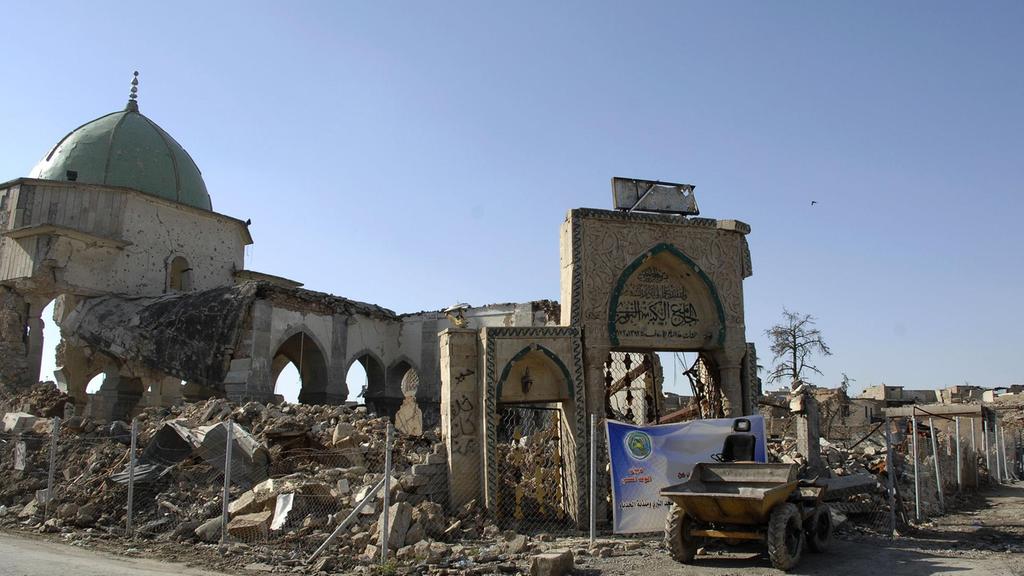Al Nuri is about more than resurrecting a building. It will also rebuild an ideology and social cohesion

Last week, the UAE announced its commitment to rebuilding the Al Nuri Great Mosque and Al Hadba minaret of Mosul, a project that is slated to be the largest feat of cultural reconstruction in Iraq. With the damage wrought by years of war and ISIS targeted attacks on Iraqi historical sites, the project is much-needed.
Strategically, it is a stroke of genius. Last week, the UAE’s Minister of Culture Noura Al Kaabi signed the first memorandum of understanding on cultural affairs between the UAE and Iraq in four decades. It comes at a time of improving UAE-Iraq relations and at a time when Iraq is looking to expand its ties with the Arab world. Local, regional and international collaboration is ensured with the involvement of Unesco, the Organisation for Islamic Cooperation and Iccrom-Athar Regional Conservation Centre in Sharjah. A project based on knowledge transfer, cultural exchanges and restoring Arab heritage provides the perfect foundation for the post-ISIS era. Among the aims of the $50.4 million endeavour is the creation of 1,000 local job opportunities, the revival of the surrounding area and providing the cornerstone for international cooperation to help areas hit by ISIS to recover. Cultural diplomacy is at its best when it immediately serves people on the ground.
The signing ceremony for the project took place at the National Museum of Iraq in Baghdad. Images of halls filled with Iraqi relics from various eras, ranging from the prehistoric to the Abbasid dynasty, had previously become synonymous with looting and loss. Images broadcast 15 years ago from the museum showed looting and destruction of artefacts thousands of years old in the immediate aftermath of the 2003 war. Last week, the image of the museum inched closer to that renewal.
The needs in Mosul are huge – from the urgency of clearing bombs planted by ISIS to helping thousands of orphans in Iraq’s second city. This has led to some questions about putting aside tens of millions of dollars to rebuild a mosque. However, Al Nuri's and Al Hadba's reconstruction are about much more than physical structures. While they have both historic and religious symbolism, the real significance is reviving Mosul and not allowing its famed minaret to remain fallen at the hands of terrorism. The reconstruction is not only of a building but of an ideology and social cohesion.
Placing cultural revival and historic restoration at the heart of efforts to revive areas affected by ISIS strikes at the heart of the terrorists’ message of destruction. Al Nuri mosque was the location of ISIS leader Abu Bakr Al Baghdadi proclaiming his false caliphate in 2014. To make it the central point of cultural renewal puts Al Nuri mosque back where it belongs as a beacon of light against the darkness of terrorism. Ever since ISIS went into Mosul, its fighters sought to erase the city’s cosmopolitan identity, from targeting Christians and Yazidis to burning its famed library. Weeks before their defeat in Mosul, ISIS fighters blew up Al Nuri Mosque and the famed minaret which had adorned Mosul’s skies for more than 800 years. The intention was to deal a final blow to the city’s identity. Instead, the Al Nuri mosque has become the home of a vision for revival in Mosul and Iraq.
The five-year feat won’t be an easy one. In speaking to various Iraqis from different generations, it was striking to find that the majority were concerned that the funds allocated to the project could be squandered or tarnished by local and international corruption. While too many local officials have made a business of aid allocations, the aid industry that has become rooted in Iraq since 2003 has created an internal dependency that obstructs the rise of local capacity.
In this well-thought out project, these concerns have been taken into consideration. With two committees overseeing the project – both a steering committee and a technical committee – will come quarterly audits to ensure the correct spending of funds. Engaging both local experts with knowledge of the site and city will be central to the project while Unesco will be bringing its world class know-how to the table.
Other practical challenges include the fear from explosives left behind by ISIS fighters and the lack of infrastructure to secure the project. In addition to the practical obstacles that might face the design and rebuilding process, there will be those intent on derailing it and keeping the UAE and other Arab countries far from Iraq. Extremists from various backgrounds – whether ISIS terrorists or pro-Iran militants – want to keep Iraq isolated.
The visit of Noura Al Kaabi, the most senior official from the UAE to visit Iraq since the fall of ISIS, came at a time of improving Iraqi-Gulf relations. In addition to high level talks at the Iraqi Ministry of Culture, the UAE official requested a meeting with Iraqi students. While logistical difficulties meant students from Mosul couldn’t attend the meeting, undergraduate and postgraduate students from Baghdad university met Ms Al Kaabi at the Iraqi national museum. Questions and comments were centred around the need for transferable skills and the desire of people to connect with the UAE and learn from its experiences. The open exchange was important and one that needs to continue in the coming months and years as Iraq regains its place among its Arab neighbours.